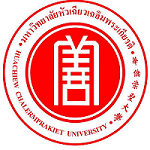Please use this identifier to cite or link to this item:
https://has.hcu.ac.th/jspui/handle/123456789/4781Full metadata record
| DC Field | Value | Language |
|---|---|---|
| dc.contributor.author | Pollawat Thongsuk | - |
| dc.contributor.author | Nitchatorn Sungsirin | - |
| dc.contributor.author | Tassanee Saovana | - |
| dc.contributor.author | Kanthima Silaram | - |
| dc.contributor.author | Sasiwimon Chan-ngam | - |
| dc.contributor.author | Anucha Yodsungnoen | - |
| dc.contributor.author | Fonthip Ruanthong | - |
| dc.contributor.author | Siriluk Phiakkhuntod | - |
| dc.contributor.author | Tanit Boonsiri | - |
| dc.contributor.author | Sudaluck Thunyaharn | - |
| dc.contributor.author | พลวรรต ทองสุข | - |
| dc.contributor.author | ทัศนีย์ เสาวนะ | - |
| dc.contributor.author | ฝนทิพย์ เรือนทอง | - |
| dc.contributor.author | ธนิต บุญศิริ | - |
| dc.contributor.author | สุดาลักษณ์ ธัญญาหาร | - |
| dc.contributor.other | Nakhonratchasima College. Faculty of Allied Health Sciences | en |
| dc.contributor.other | Phramongkutklao College of Medicine. Department of Microbiology | en |
| dc.contributor.other | Nakhonratchasima College. Faculty of Allied Health Sciences | en |
| dc.contributor.other | Nakhonratchasima College. Faculty of Allied Health Sciences | en |
| dc.contributor.other | Nakhonratchasima College. Faculty of Allied Health Sciences | en |
| dc.contributor.other | Nakhonratchasima College. Faculty of Allied Health Sciences | en |
| dc.contributor.other | Huachiew Chalermprakiet University. Faculty of Medical Technology | en |
| dc.contributor.other | Thai Red Cross Society. Regional Blood Centre V Nakhon Ratchasima | en |
| dc.contributor.other | Phramongkutklao College of Medicine. Department of Microbiology | en |
| dc.contributor.other | Sudaluck Thunyaharn Nakhonratchasima College. Faculty of Allied Health | en |
| dc.date.accessioned | 2025-11-06T03:42:16Z | - |
| dc.date.available | 2025-11-06T03:42:16Z | - |
| dc.date.issued | 2024 | - |
| dc.identifier.citation | Prog Appl Sci Tech 14, 3 (September-December 2024) : 22-30. | en |
| dc.identifier.issn | 2730-3012 (Print) | - |
| dc.identifier.issn | 2730-3030 (Online) | - |
| dc.identifier.other | DOI: 10.60101/past.2024.256342 | - |
| dc.identifier.uri | https://has.hcu.ac.th/jspui/handle/123456789/4781 | - |
| dc.description | สามารถเข้าถึงบทความฉบับเต็ม (Full Text) ได้ที่ : https://ph02.tci-thaijo.org/index.php/past/article/view/256342/171627 | en |
| dc.description.abstract | Plant proteins capable of agglutinating human red blood cells (RBCs) extend beyond traditional lectins to include ribosome-inactivating proteins (RIPs), antimicrobial peptides (AMPs), and various defense proteins. While these proteins have been extensively studied in legumes, their presence and activity in common vegetables remain largely unexplored. Understanding their distribution and specificity could reveal novel tools for glycobiology and human ABO blood typing applications. This study aimed to evaluate the agglutination activity of nine Thai vegetable extracts against human red blood cells, determine their ABO blood group specificity, and assess the correlation between protein content and agglutination strength. Additionally, we sought to identify potential plant proteins contributing to the observed agglutination patterns. In this study, crude protein extracts were prepared from nine different vegetables using phosphate-buffered saline (PBS) with pH 7.4. Total protein concentration was quantified using the Biuret method. Agglutination assays were performed using standardized human RBC suspensions from different blood groups. The specificity and strength of agglutination were evaluated using serial dilutions under controlled conditions. Among the nine extracts tested, five demonstrated significant agglutinating activity with varying specificities. Three extracts (L. polychrous mushroom, mulberry leaf, and winged bean) showed non-specific agglutination across all blood groups, suggesting the presence of broadly reactive proteins. Notably, D. biflorusseed and lima bean extracts exhibited specific agglutination against blood group A, indicating potential blood-type-specific proteins. Four extracts (C. serratumleaf, cucumber, L. leucocephalaseed and long bean)showed no detectable agglutination activity. This study reveals previously unreported agglutinating activities in common vegetable extracts, with some showing blood group specificity. The diverse agglutination patterns observed suggest the presence of both lectin and non-lectin proteins with distinct binding properties. While these findings indicate potential applications in ABO blood typing and glycobiology research, further protein characterization and improved quantification methods are needed. Future studies should focus on isolating and identifying the specific proteins or lectin responsible for the observed agglutination patterns. | en |
| dc.language.iso | en_US | en |
| dc.subject | Plant proteins | en |
| dc.subject | โปรตีนจากพืช | en |
| dc.subject | Agglutination | en |
| dc.subject | การจับกลุ่ม | en |
| dc.subject | Blood groups | en |
| dc.subject | หมู่เลือด | en |
| dc.subject | Blood groups -- ABO system | en |
| dc.subject | หมู่เลือด – ระบบเอบีโอ | en |
| dc.subject | Plant extracts | en |
| dc.subject | สารสกัดจากพืช | en |
| dc.subject | ผัก – ไทย | en |
| dc.subject | Vegetables – Thailand | en |
| dc.title | Thai Vegetable Extracts Affecting Human Red Blood Cell Surface Antigens in the ABO Blood Group System | en |
| dc.type | Article | en |
| Appears in Collections: | Medical Technology - Articles Journals | |
Files in This Item:
| File | Description | Size | Format | |
|---|---|---|---|---|
| Thai-Vegetable-Extracts-Affecting-Human-Red-Blood-Cell-Surface-Antigens-in-the-ABO-Blood-Group-System.pdf | 62.41 kB | Adobe PDF | View/Open |
Items in DSpace are protected by copyright, with all rights reserved, unless otherwise indicated.
